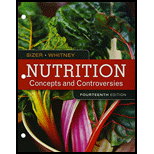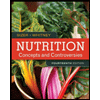
Bundle: Nutrition: Concepts and Controversies, Loose-leaf Version, 14th + MindTap Nutrition, 1 term (6 months) Printed Access Card
14th Edition
ISBN: 9781337127523
Author: Frances Sizer, Ellie Whitney
Publisher: Cengage Learning
expand_more
expand_more
format_list_bulleted
Textbook Question
Chapter 15, Problem 12SC
Which of the following is a threat to the future food supply?
- fossil fuel use
- water shortages
- ocean pollution
- all of the above
Expert Solution & Answer
Trending nowThis is a popular solution!

Chapter 15 Solutions
Bundle: Nutrition: Concepts and Controversies, Loose-leaf Version, 14th + MindTap Nutrition, 1 term (6 months) Printed Access Card
Knowledge Booster
Learn more about
Need a deep-dive on the concept behind this application? Look no further. Learn more about this topic, health-nutrition and related others by exploring similar questions and additional content below.Similar questions
- Greenhouse gases ________. a. slow the escape of heat from Earth into space b. are produced by natural and human activities c. are at higher levels than they were 100 years ago d. all of the abovearrow_forwardThe study of nutrient cycling though the environment is an example of which of the following? organismal ecology population ecology community ecology ecosystem ecologyarrow_forwardThe loss of an apex consumer would impact which trophic level of a food web? primary producers primary consumers secondary consumers all of the abovearrow_forward
- Figure 46.17 Which of the following statements about the nitrogen cycle is false? Ammonification converts organic nitrogenous matter from living organisms into ammonium (NH4+). Denitrification by bacteria converts nitrates (NO3-) to nitrogen gas (N2). Nitrification by bacteria converts nitrates (NO3 ) to nitrites (NO2-). Nitrogen fixing bacteria convert nitrogen gas (N2) into organic compounds.arrow_forwardFigure 20.12 Which of the following statements about the nitrogen cycle is false? a. Ammonification converts organic nitrogenous matter from living organisms into ammonium (NH4+) . b. Denitrification by bacteria converts nitrates (NO3) to nitrogen gas (N2) . c. Nitrification by bacteria converts nitrates (NO3) to nitrites (NO2) . d. Nitrogen fixing bacteria convert nitrogen gas (N2) into organic compounds.arrow_forwardCompared to the less developed countries, the highly developed ones have a higher ________. a. death rate c. total fertility rate b. birth rate d. resource consumption ratearrow_forward
- An organism exists for long periods by using only CO2 and H2O. herbivore. carnivore. decomposer. autotroph. heterotroph.arrow_forwardWhy are drinking water supplies still a major concern for many countries?arrow_forwardThe maximum growth rate characteristic of a species is called its _________. a. limit b. carrying capacity c. biotic potential d. exponential growth patternarrow_forward
- Which of the following is not a way that humans have increased the carrying capacity of the environment? a. agriculture b. using large amounts of natural resources c. domestication of animals d. use of languagearrow_forwardThe use of off-road recreational vehicles may double in the next 20 years. Enthusiasts would like increased access to government-owned deserts like the one shown in Figure 24.1 A. Some argue that deserts are the perfect places for off-roaders because theres nothing there. Explain whether you agree, and why.arrow_forwardFigure 45.10b If the major food source of the seals declines due to pollution or overfishing, which of the following would likely occur? The carrying capacity of seals would decrease, as would the seal population. The carrying capacity of seals would decrease, but the seal population would remain the same. The number of seal deaths would increase but the number of births would also increase, so the population size would remain the same. The carrying capacity of seals would remain the same, but the population of seals would decrease.arrow_forward
arrow_back_ios
SEE MORE QUESTIONS
arrow_forward_ios
Recommended textbooks for you
 Nutrition: Concepts and Controversies - Standalo...Health & NutritionISBN:9781305627994Author:Frances Sizer, Ellie WhitneyPublisher:Brooks Cole
Nutrition: Concepts and Controversies - Standalo...Health & NutritionISBN:9781305627994Author:Frances Sizer, Ellie WhitneyPublisher:Brooks Cole Human Biology (MindTap Course List)BiologyISBN:9781305112100Author:Cecie Starr, Beverly McMillanPublisher:Cengage Learning
Human Biology (MindTap Course List)BiologyISBN:9781305112100Author:Cecie Starr, Beverly McMillanPublisher:Cengage Learning Biology 2eBiologyISBN:9781947172517Author:Matthew Douglas, Jung Choi, Mary Ann ClarkPublisher:OpenStax
Biology 2eBiologyISBN:9781947172517Author:Matthew Douglas, Jung Choi, Mary Ann ClarkPublisher:OpenStax Biology Today and Tomorrow without Physiology (Mi...BiologyISBN:9781305117396Author:Cecie Starr, Christine Evers, Lisa StarrPublisher:Cengage Learning
Biology Today and Tomorrow without Physiology (Mi...BiologyISBN:9781305117396Author:Cecie Starr, Christine Evers, Lisa StarrPublisher:Cengage Learning


Nutrition: Concepts and Controversies - Standalo...
Health & Nutrition
ISBN:9781305627994
Author:Frances Sizer, Ellie Whitney
Publisher:Brooks Cole

Human Biology (MindTap Course List)
Biology
ISBN:9781305112100
Author:Cecie Starr, Beverly McMillan
Publisher:Cengage Learning


Biology 2e
Biology
ISBN:9781947172517
Author:Matthew Douglas, Jung Choi, Mary Ann Clark
Publisher:OpenStax

Biology Today and Tomorrow without Physiology (Mi...
Biology
ISBN:9781305117396
Author:Cecie Starr, Christine Evers, Lisa Starr
Publisher:Cengage Learning
MARINE ECOSYSTEM (Animation); Author: EarthPen;https://www.youtube.com/watch?v=-wrUr0esoI0;License: Standard YouTube License, CC-BY